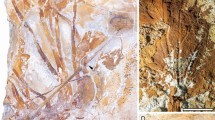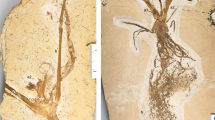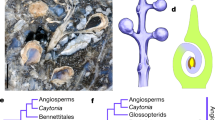Abstract
THERE are two classes of organic constituents of plants which seem to be confined to the dicotyledons: the ellagitannins (usually, if not exclusively, glucose esters of hexahydroxy-diphenic acid); and a class of substances to which the name “iridoid” has unfortunately been given, of which asperuloside (IV) and aucubin (V) are the best-known members. Following Hegnauer's use of the term aucubinartig I propose to introduce the term “aucubinoid” for these substances. These compounds and the ellagitannins are distributed in an interesting way throughout the families and orders of the dicotyledons.
This is a preview of subscription content, access via your institution
Access options
Subscribe to this journal
Receive 51 print issues and online access
$199.00 per year
only $3.90 per issue
Buy this article
- Purchase on Springer Link
- Instant access to full article PDF
Prices may be subject to local taxes which are calculated during checkout
Similar content being viewed by others
References
Hegnauer, R., Pharm. Acta Helvet., 41, 577 (1966).
Bate-Smith, E. C., J. Linn. Soc. (Botany), 58, 95 (1962).
Bate-Smith, E. C., Bull Soc. Bot. France, Mem. (1965).
Meeuse, A. J. D., Acta Botan. Neerl., 19, 133 (1970).
Takhtajan, A., Flowering Plants: Origin and Dispersal (Oliver and Boyd, Edinburgh, 1969).
Symposium on Major Evolutionary Events and the Geological Record of Plants, Biol. Rev., 45, No. 3 (1970).
Author information
Authors and Affiliations
Rights and permissions
About this article
Cite this article
BATE-SMITH, E. Chemistry and Phylogeny of the Angiosperms. Nature 236, 353–354 (1972). https://doi.org/10.1038/236353a0
Received:
Revised:
Issue Date:
DOI: https://doi.org/10.1038/236353a0
This article is cited by
-
Some observations on the chemistry and taxonomy of the tribe Bignonieae
Proceedings / Indian Academy of Sciences (1989)
-
Chemical correlates of rhesus monkey food choice: The influence of hydrolyzable tannins
Journal of Chemical Ecology (1988)
-
The origin of angiosperms
The Botanical Review (1977)
Comments
By submitting a comment you agree to abide by our Terms and Community Guidelines. If you find something abusive or that does not comply with our terms or guidelines please flag it as inappropriate.



